38 labels in assembly language examples
Embedded Systems - Assembly Language - tutorialspoint.com The names used for labels in assembly language programming consist of alphabetic letters in both uppercase and lowercase, number 0 through 9, and special characters such as question mark (?), period (.), at the rate @, underscore (_), and dollar ($). The first character should be in alphabetical character; it cannot be a number. Developing Software in Assembly Language by Valvano Sometimes the best way to learn a new technique is to observe examples. See the ReadMe.txt file for a list of examples that can be run on the simulator. There are many assembly language examples included with the TExaS application. Some simple 6812 examples are included in this document. This document has four overall parts
Know Assembly Language Programming of 8086 - ElProCus Simple Assembly Language Programs 8086. The assembly language programming 8086 has some rules such as. The assembly level programming 8086 code must be written in upper case letters. The labels must be followed by a colon, for example: label: All labels and symbols must begin with a letter. All comments are typed in lower case.

Labels in assembly language examples
SECTION V-10: Rules for Labels in Assembly Language The names used for labels in assembly language programming consist of alphabetic letters in both upper and lower case, the digits 0 through 9, and the special characters question mark (?), period (.), at (@), underline (_), and a dollar sign ($). The first character of the label must be an alphabetic character. Assembly Language Programming • ECEn 323: Computer Organization Assembly language is more readable than the binary machine code and is easier to edit and manipulate. The purpose of the "assembler" is to translate the text assembly language file written by a human into binary machine code executed by the processor (See section 2.12 in the textbook). This process is tedious and best left to a computer. pic microcontroller assembly language programming examples Labels. A label is an identifier used to represent a line in code or section of a program. Goto statements can be used in conjunction with a Label to jump to the execution of code identified by the particular label. See Task 1 code for example. ... pic microcontroller assembly language examples 6.
Labels in assembly language examples. Detailed Explanation about 8051 Programming in Assembly Language … The assembly language is a fully hardware related programming language. The embedded designers must have sufficient knowledge on hardware of particular processor or controllers before writing the program. The assembly language is developed by mnemonics; therefore, users cannot understand it easily to modify the program. 8051 Programming in ... Assembly Language Syntax by Valvano - Pennsylvania State University Examples . Assembly Language Syntax Programs written in assembly language consist of a sequence of source statements. Each source statement consists of a sequence of ASCII characters ending with a carriage return. Each source statement may include up to four fields: a label, an operation (instruction mnemonic or assembler directive), an operand ... 8051 - "Label" in Assembly language - Stack Overflow "Label" in Assembly language Ask Question 1 I have couple of examples which are pretty simple except LABEL concept. Example 1 adds 25 10 times in itself, whereas example 2 takes complement of Register A 700 times. Compiler Explorer Compiler Explorer is an interactive online compiler which shows the assembly output of compiled C++, Rust, Go (and many more) code.
Fundamentals of MIPS Programming in Assembly Language Assembly language requires very few pieces of software to learn and use. However, despite its popularity, you may not have access to a machine with a MIPS processor inside and will need a suitable emulator (or simulator) to run the examples described in this article. Spim is a 32-bit MIPS simulator, and is slightly unusual in that it does not run binary (compiled/assembled) … Little man computer - Wikipedia The Little Man Computer (LMC) is an instructional model of a computer, created by Dr. Stuart Madnick in 1965. The LMC is generally used to teach students, because it models a simple von Neumann architecture computer—which has all of the basic features of a modern computer. It can be programmed in machine code (albeit in decimal rather than binary) or assembly code. PDF Assembly Language Programming - UTEP - Labels are symbols - Labels must begin in column 1. - A label can optionally be followed by a colon - The value of a label is the current value of the Location Counter (address within program) - A label on a line by itself is a valid statement - Labels used locally within a file must be unique. Adapted from notes from BYU ECE124 5 Local Labels - Elements of Assembly Language - 123dok Here are some examples of legal identifiers: Grab Hold Widget Pot_of_Message MAXNAME A numeric label consists of a digit (0 to 9) followed by a colon. As in the case of alphanumeric labels, a numeric label assigns the current value of the location counter to the symbol.
How Are Labels Named In Assembly Language? - Quora Labels can be from 1 to 31 characters long and may consist of letters, digits, and the special characters ? . @ _ $ % If a period is used, it must be the first character Labels must not begin with a digit The assembler is case insensitive Legal and Illegal Labels Examples of legal names COUNTER1 @character SUM_OF_DIGITS $1000 DONE? .TEST What Is Assembly Language? (With Components and Example) In this example of an assembly language, "1:" is the label which lets the computer know where to begin the operation. The "MOV" is the mnemonic command to move the number "3" into a part of the computer processor, which can function as a variable. "EAX," "EBX" and "ECX" are the variables. The first line of code loads "3" into the register "eax." Labels (x86 Assembly Language Reference Manual) - Oracle When a numeric label is used as a reference (as an instruction operand, for example), the suffixes b ("backward") or f ("forward") should be added to the numeric label. For numeric label N, the reference Nb refers to the nearest label N defined before the reference, and the reference Nf refers to the nearest label N defined after the reference. Chapter Reviews- Ch. 3: Assembly Language Fundamentals True. Name the four basic parts of an assembly language instruction. Label, mnemonic, operand (s), comment. (True/False): MOV is an example of an instruction mnemonic. True. (True/False): A code label is followed by a colon (:), but a data label does not end with a. colon.
Label (computer science) - Wikipedia [1] [2] In assembly language, labels can be used anywhere an address can (for example, as the operand of a JMP or MOV instruction). [3] Also in Pascal and its derived variations. Some languages, such as Fortran and BASIC, support numeric labels. [4]
2 Assembly Language Programming - University of New Mexico In an assembly language program, a label is simply a name for an address. For example, given the declarations shown in Example 2.1, ``x'' is a name for the address of a memory location that was initialized to 23. On the SPARC an address is a 32-bit value. As such, labels are 32-bit values when they are used in assembly language programs.
AT&T Assembly Syntax | Sig9 Sep 01, 2003 · Updated: May/10 '06. This article is a 'quick-n-dirty' introduction to the AT&T assembly language syntax, as implemented in the GNU Assembler as(1).For the first timer the AT&T syntax may seem a bit confusing, but if you have any kind of assembly language programming background, it's easy to catch up once you have a few rules in mind.
PDF Notes on assembly language macros - University of North Florida • An assembly language macro is a template whose format represents a pattern of 0 or more assembly language statements that might be common to multiple programs. • For this purpose, a macro language is used to provide a syntax for defining macros. • Where a sequence of assembly language statements can be represented by a macro, a macro ...
LC3 Assembly Language.ipynb - Bryn Mawr College The assembler first goes through the source code collecting labels, and their locations. During the second pass, it can substitute the used label in the operands with the label location minus instruction location - 1. .ORIG x4000 x4000 LD R1, SIX x4001 HALT x4002 SIX: .FILL #23 .END. So, the PC-offset for SIX is x4002 - x4000 - 1 = 1.
Assembly - Label | Assembly | Datacadamia - Data and Co Grammar - Label in Assembly. A label is a name given to an addresses. Without the programmer would be required to manually calculate them. It's used to identify a target address storing: a instruction for a branch instruction (ie the value of the target address is executed) data (ie the value of target address is used as data in an operation)
Learning Assembly Language | Codementor Typically examples are telling the assembler that the following instructions are code (usually via a .text directive) vs. data (usually via a .data directive). Like regular instructions, these instructions are typically written on their own line, however, the inform the assembler rather than generate machine code instructions directly.
'Label' in assembly language - opcode - Stack Overflow The assembler translates labels into addresses when you reference them from other places. TOP: ADD B will be translated simply to 80, just as if the label wasn't there. The label address is the address where the 80 goes, the current position in the output for that line.
40 Basic Practices in Assembly Language Programming I'll analyze some examples, related to the concepts of register, memory, and stack, operators and constants, loops and procedures, system calls, etc.. For simplicity, all samples are in 32-bit, but most ideas will be easily applied to 64-bit. All the materials presented here came from my teaching [1] for years.
Directives - UTEP A comment can also be placed at the end of a source line. Comments are included in the assembly listing, but are not significant to the assembler. Examples: ; this is a comment line ldaa#$01; put $01 into reg A -> comment at end of source line * Labels - A label is a symbol followed by a colon. Labels are required on assembler directives that ...
Assembly language - Wikipedia In computer programming, assembly language (or assembler language, or symbolic machine code), often referred to simply as Assembly and commonly abbreviated as ASM or asm, is any low-level programming language with a very strong correspondence between the instructions in the language and the architecture's machine code instructions. Assembly language usually has one statement per machine ...
Assembly - Addressing Modes - tutorialspoint.com Most assembly language instructions require operands to be processed. An operand address provides the location, where the data to be processed is stored. Some instructions do not require an operand, whereas some other instructions may require one, two, or three operands. ... For example, look at the following definitions that define tables of ...
PDF Assembly Language - University of Texas at Austin NOW, Under21, R2D2, and C3PO are all examples of possible LC-3bassembly language labels. There are two reasons for explicitly referring to a memory location. 1. The location contains the target of a branch instruction (for example, AGAIN in line 0E). 2.
Guide to x86 Assembly - University of Virginia School of … In the examples above, where we used labels to refer to memory regions, these labels are actually replaced by the assembler with 32-bit quantities that specify addresses in memory. In addition to supporting referring to memory regions by labels (i.e. constant values), the x86 provides a flexible scheme for computing and referring to memory addresses: up to two of the …
What are Labels in assembly language? - Quora You don't want to use direct addresses in Assembly, both because you mostly don't want to set them hard (you want your code be relocatable) and because you'd have to change them every time when you change the code. So you just label e.g. your jump target instruction and the assembler will resolve the correct address when you build the machine code.
pic microcontroller assembly language programming examples Labels. A label is an identifier used to represent a line in code or section of a program. Goto statements can be used in conjunction with a Label to jump to the execution of code identified by the particular label. See Task 1 code for example. ... pic microcontroller assembly language examples 6.
Assembly Language Programming • ECEn 323: Computer Organization Assembly language is more readable than the binary machine code and is easier to edit and manipulate. The purpose of the "assembler" is to translate the text assembly language file written by a human into binary machine code executed by the processor (See section 2.12 in the textbook). This process is tedious and best left to a computer.
SECTION V-10: Rules for Labels in Assembly Language The names used for labels in assembly language programming consist of alphabetic letters in both upper and lower case, the digits 0 through 9, and the special characters question mark (?), period (.), at (@), underline (_), and a dollar sign ($). The first character of the label must be an alphabetic character.








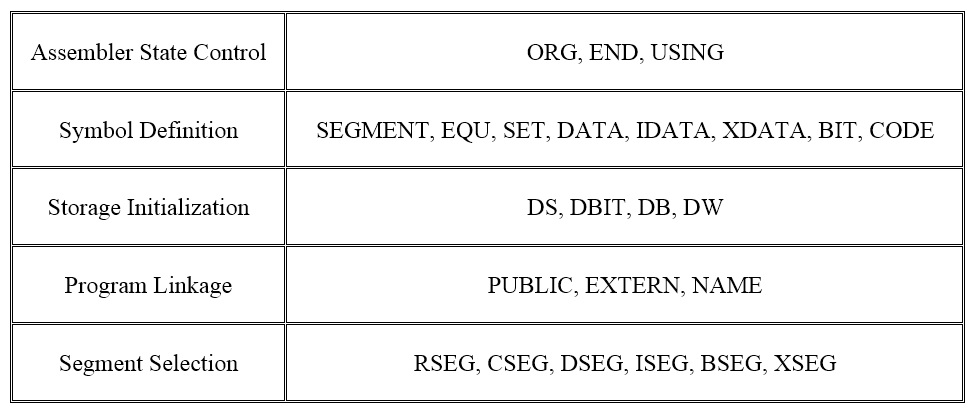
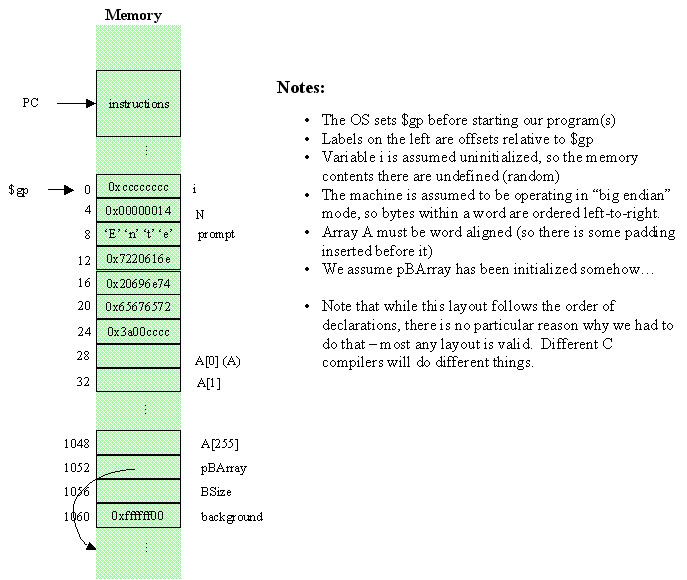
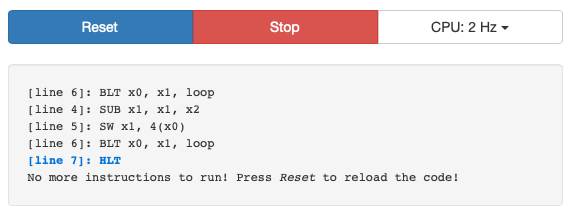



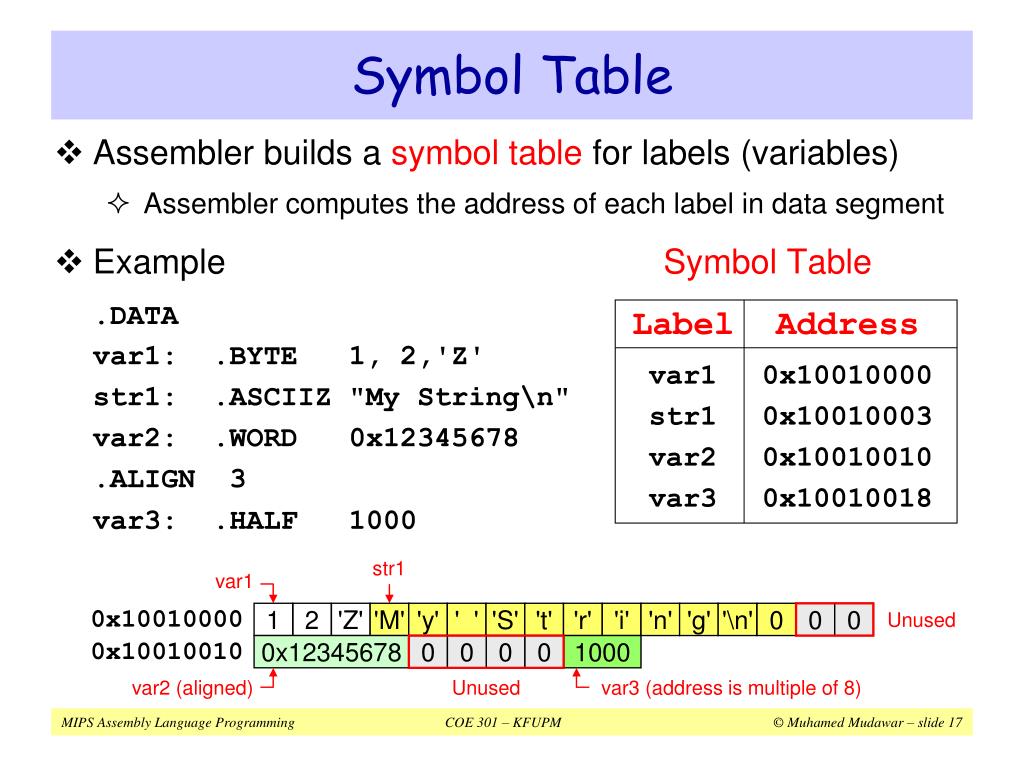







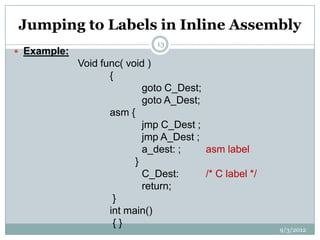
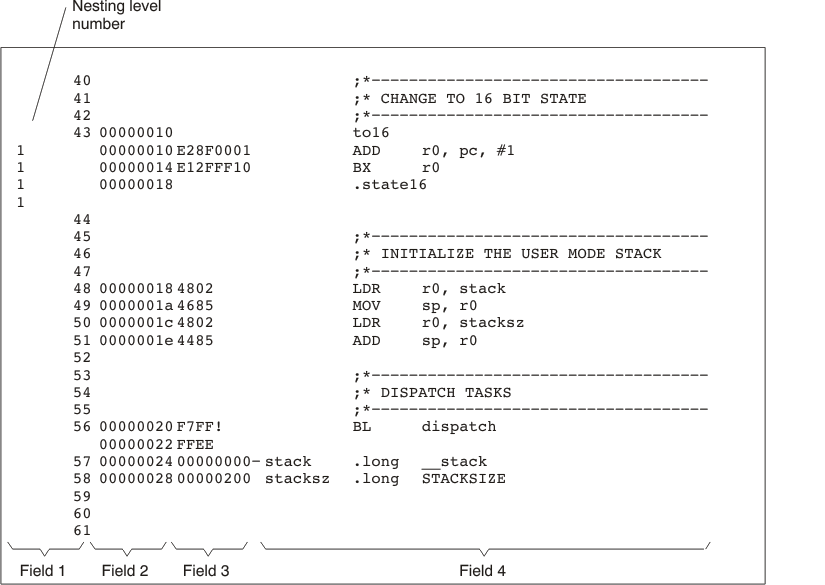



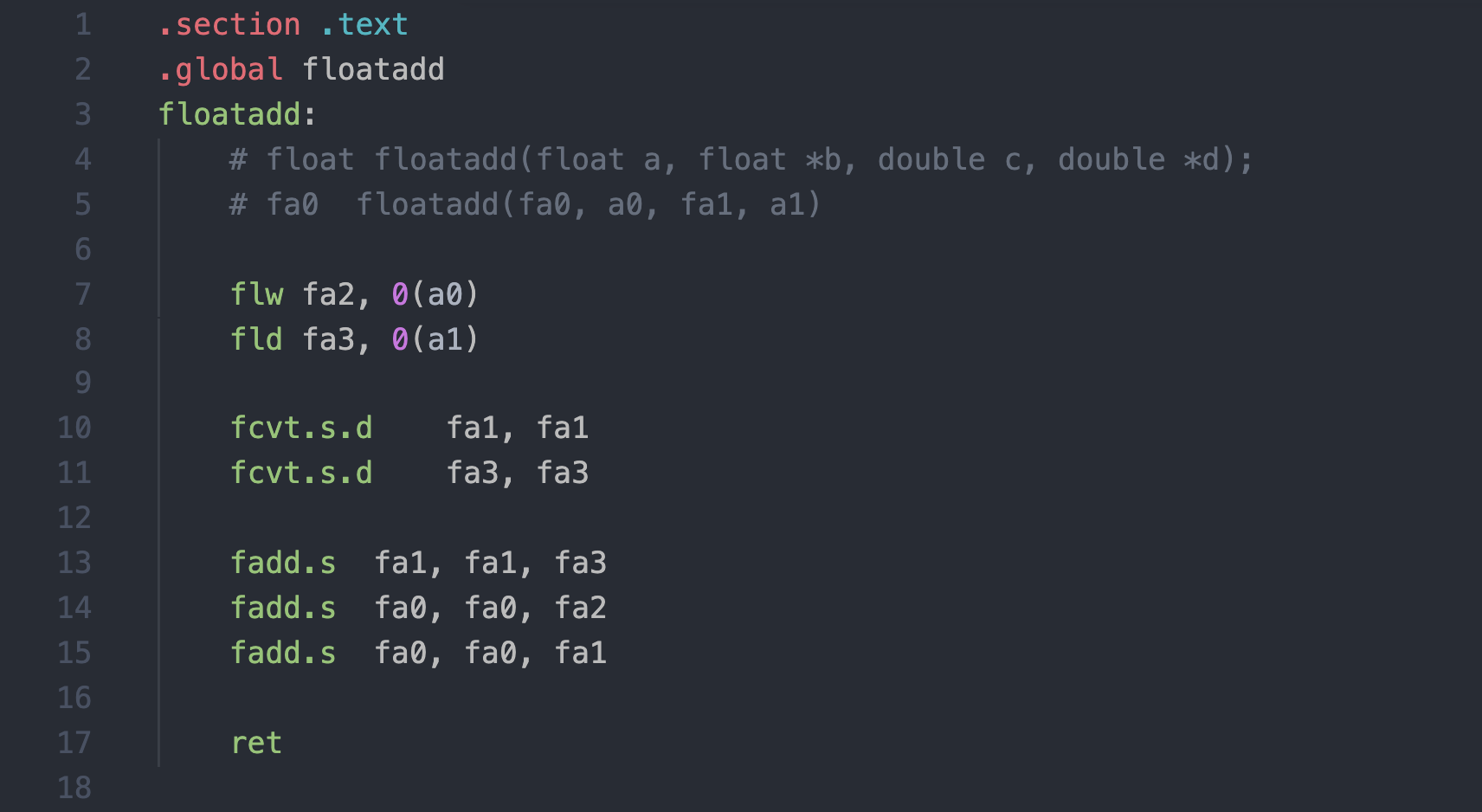


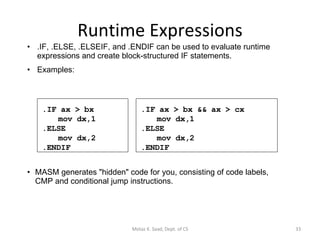


Post a Comment for "38 labels in assembly language examples"